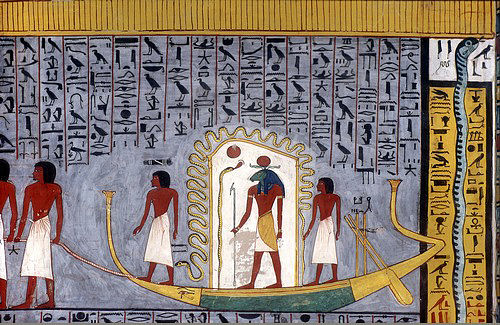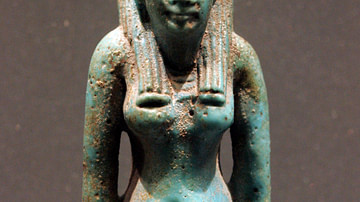The Pyramid Texts are the oldest religious writings in the world and make up the principal funerary literature of ancient Egypt. They comprise the texts which were inscribed on the sarcophogi and walls of the pyramids at Saqqara in the 5th and 6th Dynasties of the Old Kingdom (c. 2613-2181 BCE).
The texts were reserved for the soul of the deceased king by his scribes and priests and were a series of spells and incantations designed to free the soul of the king from the body and help it ascend toward the heavens. These texts are considered primary sources on the lives of the kings they were written for and have provided Egyptologists with information on the role the king played in the life of Egyptian civilization, specific accomplishments of a ruler, and even details on the individual's personality. The inscriptions also relate mythical allusions, the names of the gods, and instructions for the deceased regarding the after-life and the journey of the ka (the soul) from the body to eternal life among "the imperishable stars" where he would live with the gods.
Over two hundred gods and goddesses are mentioned in the Pyramid Texts from the most famous (such as Ra, Thoth, Osiris, and Isis) to lesser known deities. These allusions, as with all of the inscriptions, were intended to help the soul of the pharaoh in his transition from earthly life to the afterlife (known as the Field of Reeds) where he would live eternally.
The Field of Reeds was a mirror image of one's life on earth but without sickness, disappointment, or - of course - death. One would live eternally the life one enjoyed on earth but, first, one had to elude dark spirits which could lead one astray and pass through the judgment of Osiris and the Forty-Two Judges in the Hall of Truth.
The gods were clearly on the side of the king in his struggle to free himself from the former home of his body and find his way to eternal joy. They are invoked as his allies against the forces of darkness and chaos (evil spirits or demons) and as guides in the unfamiliar realm which followed life on earth.

The Utterances
These inscriptions do not relate the myths of Egypt in full but only allude to events in the mythology or iconic moments which would symbolize concepts such as harmony, restoration, stability, and order. Potent gods such as Thoth (god of wisdom and writing) or Horus (restorer of order) are invoked to help the king and the allusions to the myths (such as The Contendings Between Horus and Set in which order overcomes chaos) would remind his soul of the presence of the gods and their good will. The sun god Ra is mentioned repeatedly, assuring the soul of continued light, warmth, and comfort. The pyramid texts also provide the first written reference to the great god Osiris, king of the dead, and the concept of the judgement of the soul in the Hall of Truth and, in doing so, try to assure the king that he will pass through this judgment safely.
The so-called "utterances" are inscriptions meant to be spoken out loud (hence their designation) and, by the way in which they are written, most likely chanted. According to the scholar Geraldine Pinch, "Many were composed in the first person and would have been highly drmatic when spoken or chanted aloud" (10).
In the utterance which details the deceased pharaoh's journey into the sky, for example, verbs like "flieth", "rusheth", "kissed" and "leapt" are written to be emphasized: "He that flieth, flieth! He flieth away from you, ye men. He is no longer in the earth. He is in the sky. He rusheth at the sky as a heron. He hath kissed the sky as a hawk. He hath leapt skyward as a grasshopper" (Nardo, 113). Each utterance corresponds to a chapter in a book; a book to be read aloud to the soul of the deceased. This `book', however, was no doubt originally an oral tradition which in time came to be written on the walls of tombs.
Creation & Use of the Texts
The priests of the Old Kingdom are credited with the creation of these works and inter-textual evidence strongly suggests that they did so in order to provide the king's soul with detailed knowledge of the after-life and how to arrive there safely. Some utterances, which call upon the gods to help and guide, also comfort the soul and assure it that this passage from the body is natural and not to be feared.
Other utterances seem to assure those living (and chanting the words) that the soul has arrived safely: "He hath gone up into the sky and hath found Ra, who standeth up when he draweth nigh unto him. He sitteth down beside him, for Ra suffereth him not to seat himself on the ground, knowing that he is greater than Ra. He hath taken his stand with Ra" (Nardo, 115). Geraldine Pinch notes:
The main purpose of assembling these texts and inscribing them inside pyramids was to help the body of the deceased king to escape the horror of putrefaction and his spirit to ascend to the celestial realm where he would take his place among the gods. Some of the texts were probably recited during the king's funeral or as part of the mortuary cult that continued after his death. Others may have been intended to be spoken by the deceased king as he entered the afterlife. (11)
The soul of the deceased could fly or run or walk or even row to the Field of Reeds in a ship as this passage indicates: "A ramp to the sky is built for him that he may go up to the sky thereon. He goeth up upon the smoke of the great exhalation. He flieth as a bird and he settleth as a beetle on an empty seat on the ship of Ra… He roweth in the sky in thy ship, O Ra! And he cometh to the land in thy ship, O Ra!"
The soul's flight, of course, could only take place after the deceased had passed through the judgement of Osiris in the Hall of Truth and had the heart weighed in the golden balances against the white feather of Truth (the feather of Ma'at, goddess of harmony and balance). While the Pyramid Texts are the first to mention the Judgement of Osiris, the concept would be fully developed in writing later in the Book of Coming Forth By Day, better known as The Egyptian Book of the Dead which drew on the Pyramid Texts.
The Journey of the Soul
The ship of Ra was closely associated with the sun and the texts indicate that the soul, having passed through the judgement, would travel with the ship of Ra through the dark underworld but, always, would rise toward the zenith of heaven with the morning and proceed on to the Field of Reeds where one would enjoy eternal life in a land very like that which the spirit knew on earth, ever in the benevolent presence of the great gods and goddesses like Osiris, Ra, Isis, and Ma'at.
This boat, known as the Ship of a Million Souls, was the sun barge which the justified dead would help Ra to defend from the serpent Apep (also known as Apophis) who tried to destroy it each night. This is only one version of the vision of the afterlife the texts present with another being the better known judgment in the Hall of Truth followed by a journey across the water rowed by the boatman Hraf-haf ("He Who Looks Behind Him") who brought the justified souls to the Field of Reeds.
The Egyptians believed that their earthly journey was only a part of an eternal life lived in the presence of the gods. The gods imbued their daily lives with meaning and the promise that death was not the end. All of Egypt was alive with the presence of these gods and the people held the land so dearly that they disliked extensive travel or military campaigns which would take them beyond its borders because of their belief that, should they die outside Egypt, they would have a harder time reaching the Field of Reeds - or may never reach it at all.
Even for those who died within the country's borders, however, it was recognized that the transition to the afterlife would be a frightening change from what one was used to. The Pyramid Texts served as assurances that, in the end, all would be well because the gods were there in death as they had been in life, and would guide the soul safely to its eternal home.






